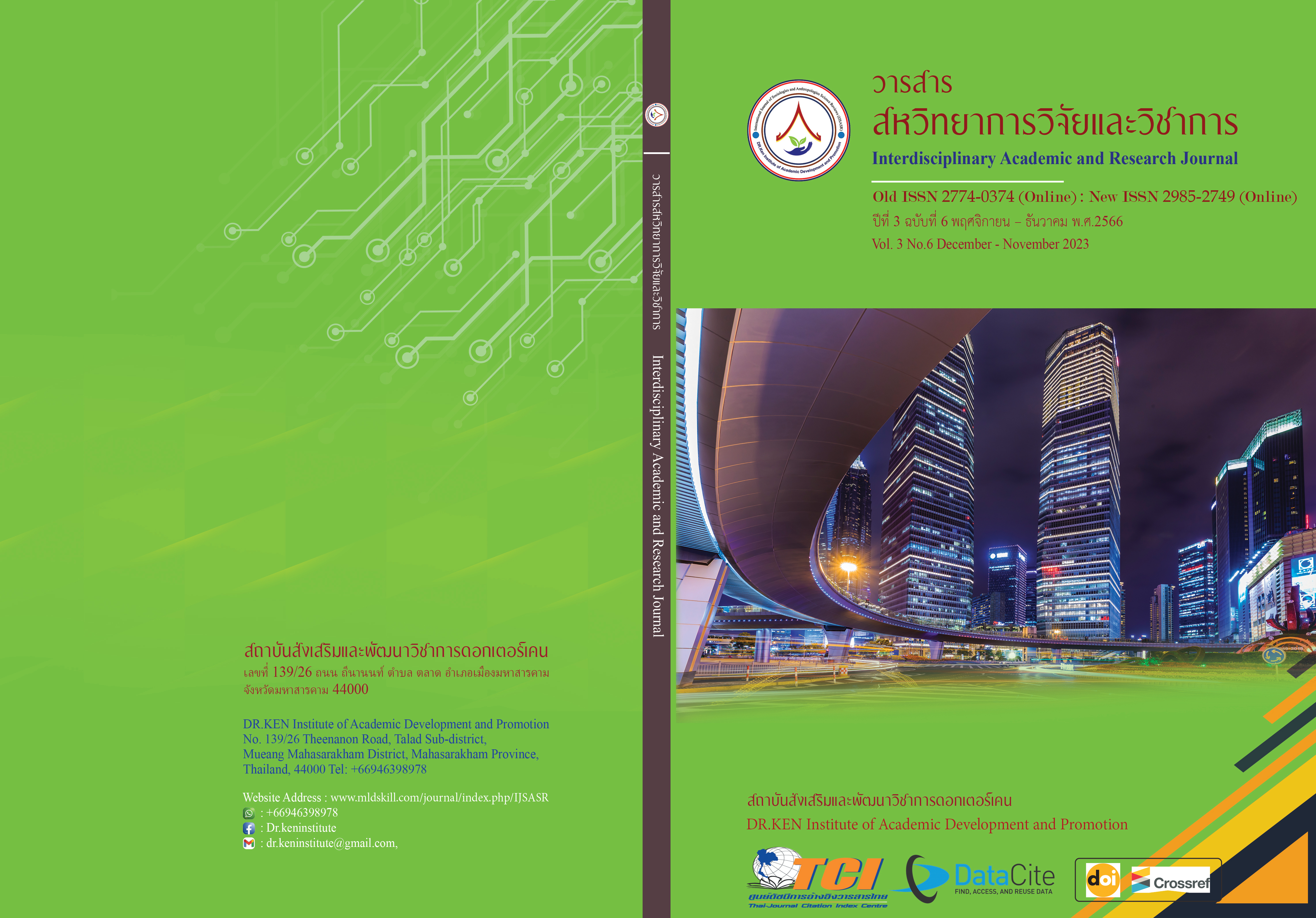The Result Development of Teaching Activities of Thai Literature by Using the DACIR Instructional Process for Student Bachelor of Education Program in Thai Language
DOI:
https://doi.org/10.60027/iarj.2023.270078Keywords:
DACIR Instructional Process; , The development of Thai Literature; , Teaching ActivitiesAbstract
Background and Aims: The development of teaching and learning will encourage learners to achieve the objectives of the Thai Literature Development course through the organization of teaching and learning activities that focus on students asking important questions and formulating assumptions in the study. This correlates with the DACIR teaching and learning process, which aims to develop learners' ability to think analytically, and inferiorly and interact with a variety of sources of information. Thus, the purpose was to study 1) The development of teaching activities of Thai literature by using the DACIR instructional process, 2) the Comparison of achievement for the development of Thai literature, and 3) the Satisfaction of the learner to teaching activities of the development of Thai literature.
Methodology: The sample group was 60 people of 3rd-year students in the Thai program, semester 1/2022 at Thepsatri Rajabhat University by simple random sampling. The research tools include teaching activities of Thai literature by using the DACIR instructional process, measuring achievement, and satisfaction questionnaire. Data were analyzed by using context validity, mean, standard deviation, and t-test.
Results: The results found that 1) teaching activities of the development of Thai literature by using the DACIR instructional process were context-valid at the highest level. 2) Achievement in the development of Thai literature after learning was higher than before learning with statistical significance at the .05 level. 3) The learners were satisfied with the teaching activities of the development of Thai literature at the highest level.
Conclusion: It was found that learning activities in the Thai literature course using the DACIR method have the highest content validity and exhibit high learning effectiveness. Overall, learners expressed the highest satisfaction with these activities.
References
กระทรวงศึกษาธิการ. (2551). หลักสูตรแกนกลางการศึกษาขั้นพื้นฐานพุทธศักราช 2551. กรุงเทพฯ: กระทรงศึกษาธิการ
ชัยรัตน์ โตศิลา. (2555). การพัฒนากระบวนการเรียนการสอนโดยใช้วิธีการทางประวัติศาสตร์ เพื่อส่งเสริมทักษะการคิดทางประวัติศาสตร์ของนักเรียนมัธยมศึกษาปีที่ 2. วิทยานิพนธ์ระดับปริญญาดุษฎีบัณฑิต สาขาวิชาหลักสูตรและการสอน จุฬาลงกรณ์มหาวิทยาลัย.
ณรงค์ฤทธิ์ ศักดิ์แสน. (2560). ผลของการใช้กระบวนการเรียนการสอนแดคีร์ที่มีต่อการเข้าถึงความรู้สึกทางประวัติศาสตร์และเจตคติต่อการศึกษาประวัติศาสตร์ของนักเรียนมัธยมศึกษาปีที่ 4. วิทยานิพนธ์ระดับมหาบัณฑิต สาขาวิชาการสอนสังคมศึกษา มหาวิทยาลัยศิลปากร.
ทีฆกุล คำงาม. (2560). ผลของการจัดการเรียนรู้ประวัติศาสตร์ท้องถิ่นโดยใช้กระบวนการเรียนการสอน DACIR ที่มีต่อการเรียนรู้มโนทัศน์ทางประวัติศาสตร์ของนักเรียนประถมศึกษาปีที่ 5. วิทยานิพนธ์ระดับมหาบัณฑิต สาขาวิชาการสอนสังคมศึกษา มหาวิทยาลัยศิลปากร.
นันทญ์ณภัค พรมมา. (2563). การพัฒนาผลสัมฤทธิ์ทางการเรียนวรรณคดีไทยของนักเรียนชั้นมัธยมศึกษาปีที่ 3 ด้วยการใช้เทคนิคเพื่อนคู่คิด. วิทยานิพนธ์นี้ศึกษาศาสตรมหาบัณฑิต สาขาวิชาการสอนภาษาไทย มหาวิทยาลัยศิลปากร.
บุญชม ศรีสะอาด. (2558). การวิจัยเบื้องต้น. กรุงเทพมหานคร: สุวีริยาสาส์น.
ภูวดล วิริยะ. (2561). การนำเสนอกิจกรรมการเรียนการสอนเหตุการณ์โลกในยุคปัจจุบันสำหรับนักเรียนมัธยมศึกษาตอนปลาย. วิทยานิพนธ์หลักสูตรศึกษาศาสตรมหาบัณฑิต สาขาวิชาการสอนสังคมศึกษา มหาวิทยาลัยศิลปากร.
ยุทธศิลป์ แปลนนาค. (2559). ผลของการจัดการเรียนรู้ประวัติศาสตร์โดยใช้กระบวนการเรียนการสอนแดคีร์ที่มีต่อทักษะการอ่านอย่างมีวิจารณญาณและความสามารถในการตั้งคำถามสำคัญทางประวัติศาสตร์ของนักเรียนมัธยมศึกษาปีที่ 4. วิทยานิพนธ์ระดับมหาบัณฑิต สาขาวิชาการสอนสังคมศึกษา มหาวิทยาลัยศิลปากร.
รื่นฤทัย สัจจพันธุ์. (2549). ความรู้ทั่วไปทางภาษาและวรรณกรรมไทย. กรุงเทพฯ: ภาควิชาภาษาไทย และภาษาตะวันออก คณะมนุษยศาสตร์ มหาวิทยาลัยรามคำแหง.
สมศักดิ์ ภู่วิภาดาวรรธน์. (2554). การยึดผู้เรียนเป็นศูนย์กลางและการประเมินตามสภาพจริง. เชียงใหม่: โรงพิมพ์แสงศิลป์.
หลักสูตรครุศาสตรบัณฑิต สาขาวิชาภาษาไทย ฉบับปรับปรุง พุทธศักราช 2562. (2563). สาขาวิชาภาษาไทย คณะมนุษศาสตร์และสังคมศาสตร์ มหาวิทยาลัยราชภัฏเทพสตรี.
อิ่มจิตร หมวดแร่, สุนทร อ่อนฤทธิ์ และชัยรัตน์ โตศิลา. (2565). การพัฒนากิจกรรมการเรียนรู้อาเซียนศึกษาโดยใช้แนวคิดการเรียนรู้แบบกิจกรรมเป็นฐานเพื่อส่งเสริมสมรรถนะการเป็นพลเมืองที่เข้มแข็งของนักเรียนระดับมัธยมศึกษาตอนปลาย. วารสารวิชาการคณะมนุษยศาสตร์และสังคมศาสตร์มหาวิทยาลัยราชภัฏเทพสตรี. 13(3), 1-16.
Drake, F. D., and Brown, S. D. (2003). A Systematic Approach to Improve Students' Historical Thinking. History Teacher, 34, 4-29.
Meredith, M. (2015). Current Events in the Classroom: A Collection of Case Studies on the Why and How of Using the News to Teach Curriculum. Master Thesis, Faculty of Education, University of Toronto.
Moore, K. (2015). Keeping Current: Media Literacy Education as a Tool for Critically Examining Current Events in a High School Government Classroom. Master Thesis, Faculty of Education, University of Mary Washington.
Downloads
Published
How to Cite
Issue
Section
License
Copyright (c) 2023 Assistant Professor Chanitta Chotchuang

This work is licensed under a Creative Commons Attribution-NonCommercial-NoDerivatives 4.0 International License.
Copyright on any article in the Interdisciplinary Academic and Research Journal is retained by the author(s) under the under the Creative Commons Attribution-NonCommercial-NoDerivatives 4.0 International License. Permission to use text, content, images, etc. of publication. Any user to read, download, copy, distribute, print, search, or link to the full texts of articles, crawl them for indexing, pass them as data to software, or use them for any other lawful purpose. But do not use it for commercial use or with the intent to benefit any business.
















.png)


